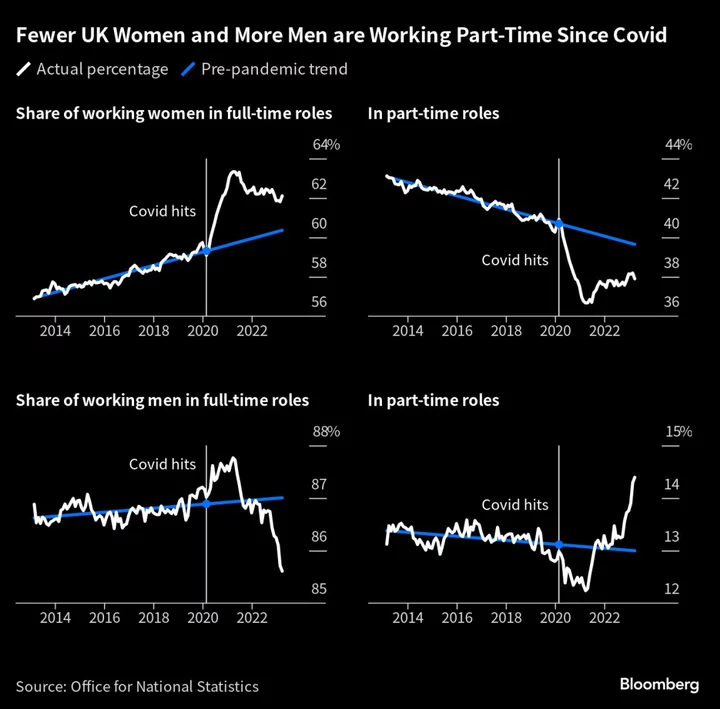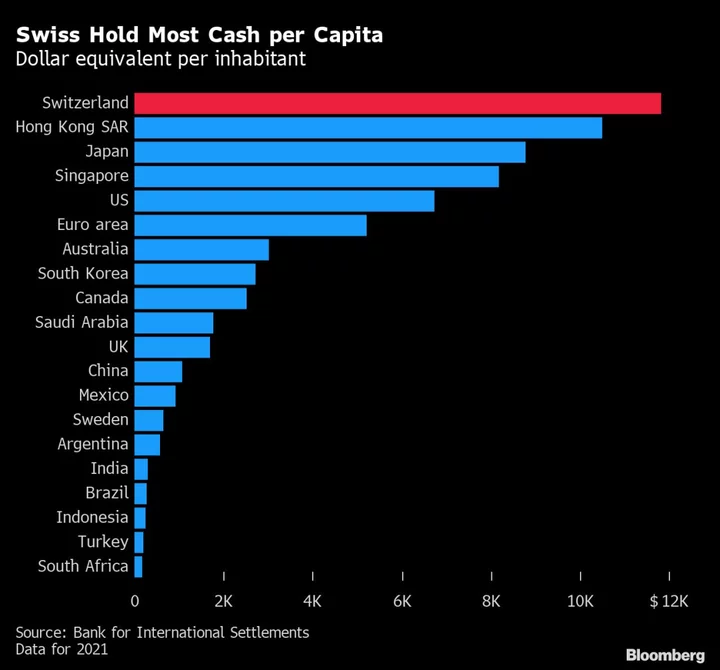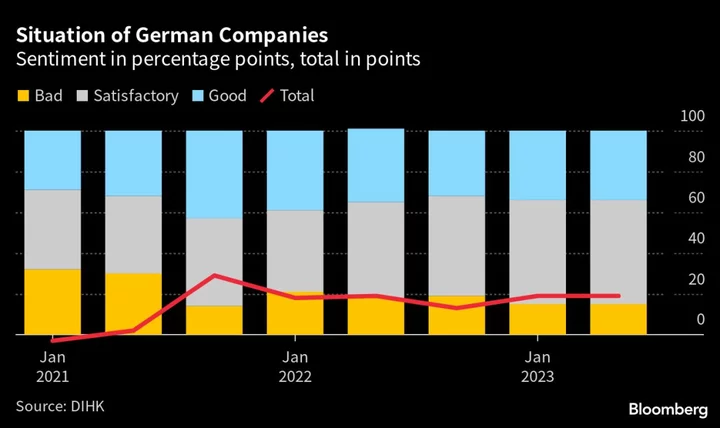A push to return more British workers into the office risks undercutting a surge in the hours that women spend on the job, reversing one of the few positive trends for the economy.
Women in the UK are putting in more time at work than ever before thanks to “hybrid work” policies that sprang up during the pandemic, allowing employees to split their time between the office and home, an analysis of official data by Bloomberg shows.
Analysts and employment experts warn that those gains, which have helped ease strains in a tight labor market, are at risk as businesses dial back flexibility.
Those conclusions shed light on trends in the labor market that the Bank of England is watching carefully as it gages how high it must push up interest rates to contain inflation. A drop in the number of people in the workforce during the pandemic pushed up wages and is feeding through to higher prices that the government and central bank want to halt.
Government data from the Office for National Statistics shows the number of hours worked in the UK is finally back above pre-pandemic levels, unwinding the impact of lockdowns that shut businesses and pushed employees onto a state-supported furlough program.
It’s women who have driven that rebound, ONS data show, with hours worked per woman are up almost 5% on levels before Covid-19 struck. Men, on the other hand, are spending fewer hours on the job — accelerating the downward trend that began in the decade before the first Covid lockdown.
The findings indicate a bit of relief for tightness in the UK labor market, where vacancies remain near record highs and workers are in short supply due to Brexit and a surge in long-term sickness since the pandemic. The uptick in women’s working hours is easing some of that pressure. The ONS will deliver a fresh batch of figures on Aug. 15.
For Prime Minister Rishi Sunak’s government, which is desperate to get inflation down ahead of a general election expected next year, easing pressure on the labor market while keeping as many people employed as possible is a big priority. Chancellor of the Exchequer Jeremy Hunt has vowed to extend state-backed free childcare hours to younger children, but there’s still a question about how this will be funded and if there’s enough carers to meet demand.
Initially, the pandemic was a setback for working parents, since they had to juggle jobs with full-time child care. Women were hardest hit since they took the biggest care responsibilities. But as nurseries and schools reopened, hybrid work practices made it easier for people to spend time on the job while making sure their children were where they needed to be. The data show women took advantage of that flexibility to spend more hours on the job.
The concern is that some businesses are working against the favorable trend. JPMorgan Chase, Amazon.com Inc., Blackrock and Goldman Sachs are at the vanguard of limiting hybrid work, asking for staff to spend more time in the office and reducing the flexibility that has brought more work from women.
“Covid taught us a lot of things when we were right in the middle of it,” said Louise Ballard, co-founder of business consultancy Beyondable, which aims to empower female workers. “And then there’s just been this slow creep back on so many levels.”
Tony Wilson, director of the Institute for Employment Studies, thinks the increase in women’s hours and the drop in men’s “likely broadly reflects people being able to work more of the hours that they want in a tight labor market.”
More women have shifted from part-time to full-time work, according to the ONS data. There’s also been a drop in the number who say they’re working part-time because they couldn’t find full-time jobs.
Meanwhile, the number of men taking on part-time jobs has jumped along with the portion who say it’s because they don’t want a full-time position.
All of this suggests there has been some shift in the way household chores are being balanced by couples, Wilson says. The rise in women working longer hours “has probably been supported by more parents being able to stay working full time — or return to full time — because it’s a bit easier to do that in a hybrid world,” he adds.
Daniela Korn, co-owner and head of the employment practice at law firm Tan Ward, saw many of her senior executive clients upping their hours and going full-time when Covid offered them a more flexible schedule.
“Previously, the flexibility would’ve cost them quite clearly in terms of their salary,” she says. “There’s now an opportunity for them to be able to work more hours, but in a manner that suits them.”
Pandemic lockdowns may have also made some men realize the possibilities that part-time work can offer, Wilson says.
Research has also suggested women are bearing the brunt of Britain’s inflation crisis, and it’s possible this could be causing many to take on overtime and second jobs to help pay the bills. While the number of people with second jobs has increased above pre-pandemic levels, according to ONS data, this is adding to women’s working hours far more than men’s.
“The balancing act between working life and caring responsibilities was put firmly under the microscope during the pandemic,” says Lisa Fernihough, chief people officer at KPMG UK. “One of the few positives to come out of the pandemic was more flexible working.”
Read more:
- Closing the Gender Pay Gap Requires Teeth, Not Just Transparency
- One in Four British Parents Quit Jobs or Education Because of Child Care Costs
- Zoom Summons Employees Back to Office as Remote Work Era Wanes
- Job Seekers’ Interest in Flexible Work Arrangements Is Surging
--With assistance from Irina Anghel.









